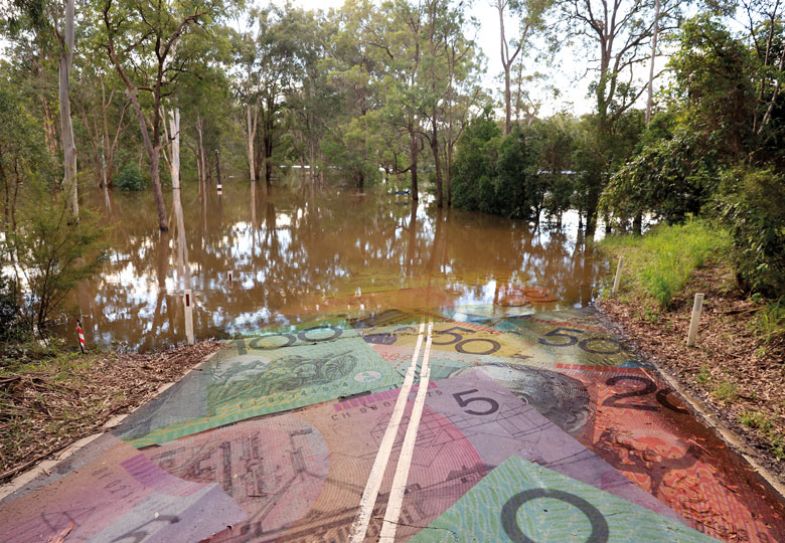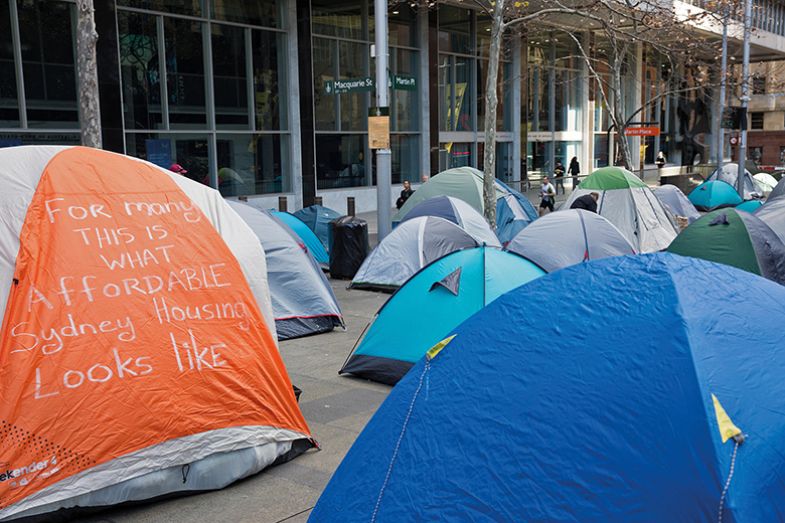When Denise Bradley was up to her elbows reviewing Australia’s higher education system 15 years ago, she was tempted to put student income support in the too-hard basket. Speaking to reporters following the release of her seminal 2008 report, she said she had intended to handball the complex issue to another reviewer. Income support was an unholy mess, and Bradley had other fish to fry.
But she realised that kicking the can down the road would help nobody. It might be years before another opportunity arose to untangle a system that had become so skewed that the inadequate flow of support money was often monopolised by those with least need for it.
Bradley rolled up her sleeves and dived into the policy weeds. She found an income support system replete with design flaws. Most master’s students were excluded. Policy settings differed from those in other social security schemes, in ways that disproportionately disadvantaged the most underprivileged. Inadequate indexation for inflation had eroded the real value of support payments. The “personal income test” – the amount of extra income students could earn before losing benefits – had not changed for 15 years. The “parental income threshold”, which determined whether families had the means to support students, was less than three-quarters of the equivalent figure for other types of social security. The “taper rate” – the progressive reduction in benefits paid to recipients from the same family – was 25 per cent and applied to each new sibling, while the rate was 20 per cent in other schemes and applied only once. This left large low-income households increasingly stretched every time another child made it through the university gates.
Struggling students found themselves in increasingly desperate circumstances. Between 2001 and 2007, as domestic enrolments rose by more than 150,000, the number of students receiving income support declined by 12,000. By 2006, Australian undergraduates relied on paid work for two-thirds of their income, up from about half in 2000, as the purchasing power of the average benefit nosedived by 27 per cent. Almost three-quarters of full-time domestic undergraduates reported working during semesters, typically 15 hours a week. Of those still lucky enough to attract income support, a declining share received full benefits. And even those fortunate few struggled to meet basic living costs. About 7 per cent said they could not afford to travel to campus. Ten per cent said they had deferred their studies – sometimes for years – for affordability reasons, and 5 per cent faced dropping out completely.
Some analysts think Bradley’s work to improve income support arrangements was the finest achievement of a once-in-a-generation review that also produced the demand-driven funding system and the higher education regulator the Tertiary Education Quality and Standards Agency (Teqsa). But as rampaging inflation pushes Australia’s already sky-high living costs into the stratosphere, things have become worse than ever.

A November 2022 report from Australia’s National Union of Students (NUS) found that of some 450,000 higher education students aged 18 to 22, more than 70 per cent were ineligible for Youth Allowance (YA) – the main income support stream for students under 25 – because it was presumed that their parents had the means and inclination to support them. For the blessed few on benefits, most received less than A$26 (£14) a day, barely one-quarter of the A$88 poverty line as calculated by the University of Melbourne’s Melbourne Institute of applied economic and social research.
In a self-selecting survey, 38 per cent of student respondents reported that they were in insecure housing. Fifty-six per cent said financial hardship had affected their academic results, and 65 per cent said it had harmed their mental health.
Things have arguably deteriorated since then, with inflation currently in excess of 7 per cent – the highest in 30 years. Rental accommodation is scarce and priced beyond the reach of many students.
“We’re in a cost-of-living crisis,” says NUS 2022 president Georgie Beatty. “Students are having to pick up extra shifts. You have to do more hours to be able to afford to live, [in] jobs that are highly casualised and minimum wage. For students [without] anyone they can rely on to support them – which is a fair chunk of students – full-time study is something they can’t afford.”
Beatty says that even with Australia’s policy spotlight focused on diversifying student intakes, income support receives surprisingly little attention. “The biggest barrier is not how much the degree costs. It’s the fact that there is no welfare support to help you get there,” she says.
That view is shared by economics graduate Maxwell Yong, who made headlines with an analysis of the impact of tuition fee hikes on course choice while undertaking honours studies at the University of Melbourne. Referring to the income-contingent student loan scheme known as the Higher Education Contribution Scheme (Hecs), he says: “When it comes to accessing university places, everyone thinks it’s a Hecs problem. It’s not: it’s a welfare problem. People from low socio-economic backgrounds don’t have to pay tuition fees upfront, but many can’t survive because they can’t get Youth Allowance until they’re 22. Lots of students are going hungry. They can’t keep…feeding themselves while they’re studying for three years instead of earning a wage.”
Under current arrangements, “dependent” students aged under 22 can receive full YA benefits only if their parents earn less than about A$56,000 a year – some A$4,000 below the poverty line for a single-income couple with two dependent children – while parental earnings of A$70,000 render students ineligible for any benefits at all, even if they live outside the family home.
Yong says revising YA eligibility arrangements is “probably the easiest policy lever” to boost disadvantaged students’ enrolment rates, while noting that it would entail the tweaking of social service administrative arrangements to resolve an educational problem. “Those departments don’t speak to each other very well,” he concedes. But income support is not an issue only for disadvantaged students, he adds. “Some students can be financially separated from their parents. They may have no contact with their wealthy parents, so they are not financially supported but still cannot access welfare.”
Academics and administrators agree that income support is a large, neglected aspect of equity in Australian higher education. University of Wollongong vice-chancellor Patricia Davidson says students tell her they are struggling to get to campus amid soaring petrol costs and pressure from their employers to “just do one more shift”.
“Equity” students are asking themselves even more fundamental questions, according to UNSW Sydney deputy vice-chancellor Eileen Baldry. “Can I eat? Can I afford the rent? [Will I spend] every other waking moment, when I’m not studying, working as an Uber food driver or whatever it happens to be, so I can’t enjoy the whole social milieu and the connection [of] a university experience?”
Nor is the issue confined to Australia, as high inflation pushes up living costs around the world. For instance, Sir Philip Augar, who chaired England’s Review of Post-18 Education and Funding in 2018-19, also recognised income support for university students as a major issue, recommending the reintroduction of maintenance grants for those from low-income households – reversing their abolition three years earlier in favour of loans.
Augar says the financial challenges facing students have only escalated since he lodged his report. “You get pressure on rents in an environment where accommodation is in short supply. You get inflationary pressure on energy prices, food costs and transport. There’s absolutely no doubt that it’s more of an issue – particularly for the underprivileged, because parents are unable to afford to help them. It’s not just the students facing the pressure: it’s family support networks around the students. It’s very much at the sharp end.”

Australia’s higher education community is looking to its updating of the Bradley review, referred to by the Labor government in its general election campaigning last year as a “universities accord”, to address such challenges. While the review’s terms of reference, unveiled in November, do not specifically mention income support, they are considered broad enough to accommodate any recommendations, and education minister Jason Clare has highlighted equity as his primary policy concern.
Former Melbournite Gavin Moodie, now an adjunct professor at the Ontario Institute for Studies in Education at the University of Toronto, agrees that student income support is the “biggest equity issue” in Australian higher education. He says two “big changes” are needed: parental means tests must be relaxed, and income support levels must be increased substantially.
The NUS goes further, recommending that the “age of independence” – the threshold age for eligibility to full YA – be lowered from 22 to 18, with payment levels raised to at least A$88 a day. The union also wants social security payments reviewed regularly in light of cost-of-living rises and calls for rent assistance payments to be increased to reflect “the realities of the rental market”.
The NUS says the increased payment levels alone would cost A$5.7 billion a year, while Bradley costed the reduction of the age threshold from 22 to 18 at A$1.5 billion even back in 2008. She avoided such “prohibitively expensive” recommendations, opting for cheaper measures that the government could stomach.
Bradley estimated that her reform recipe – boosting indexation of payments, aligning income tests and taper rates with those in other schemes, reforming scholarships and reducing the age of independence from 25 to 22 – would extend eligibility to as many as 63,000 extra undergraduates while increasing benefits to another 73,000.
This would be partly offset by reducing or erasing benefits for some 34,000 often wealthy recipients. This was achieved mainly through the abolition of an “independence” test introduced 10 years earlier, under which students were considered self-supporting – and therefore warranting taxpayer support – if they had earned at least A$18,850 over an 18-month period since leaving school; well-heeled kids could achieve this by working casually during a gap year “or even being ‘employed’ by their families”, Bradley noted. By 2007, well over 20,000 “independent at home” youngsters a year were using this route to qualify for full benefits – referred to in Sydney’s leafier suburbs as “beer money”. An analysis of survey data found that almost half of YA recipients “living at home” had household incomes above the maximum parental income threshold for any social welfare benefits whatsoever. Over one-third were in households with six-figure incomes, some as much as A$400,000 a year.
One challenge for the accord panel, to be chaired by former University of Adelaide vice-chancellor Mary O’Kane, is to find other policy quirks and loopholes to offer up as savings, so that more benefits can be redirected to the students who really need them. Such an opportunity might lie in more meaningful “independence” tests. Under current arrangements, all undergraduates aged over 21 attract full benefits as “independent” students – including those living in the family home – while younger rural students are denied access even if they must move far from home, thereby satisfying a common-sense definition of independence.
The NUS says it is “open” to sensible trade-offs. “Independence should be treated as independence,” says Beatty. “We’re happy to concede that maybe a student living at home does not need welfare support. What we’re really trying to catch is the students who are out of home, independent and broke because the government just expects them to be supported by their parents.”
Regional students could be deemed independent, for example, if they moved to study at a campus at least a 90-minute public transport trip from their family home. This is already an eligibility requirement for the Tertiary Access Payment (TAP), a one-off payment of up to A$5,000 to help rural students cover the cost of moving. But a policy catch-22 renders students ineligible for the TAP if they take a “gap year” – something many regional youngsters must currently do to earn eligibility for YA, under an “independence” criterion requiring them to work an average of 30 hours a week for at least 18 months. “The way the welfare system is structured is anything but sensible,” Beatty notes.
Other equity measures that could be implemented at low cost to the government include raising the tax-free threshold for current students and allowing YA recipients to earn more money on the side before relinquishing some of their benefits. “The system should be able to accommodate 10 or 15 hours of work a week in addition to the income support,” says Andrew Norton, professor in the practice of higher education policy at the Australian National University. “Between them, hopefully students will get an adequate level of income.”

Inflation has not been universally bad for welfare recipients, including students, whose benefits are indexed in line with living costs. On 1 January, payments and personal earning limits for YA and Austudy – the support scheme for students aged over 25 – all increased by 6.1 per cent. It was reportedly the largest rise in student benefits in 25 years, apart from a temporary supplementation of payments during the early stages of the coronavirus pandemic.
The federal government has also undertaken to review the adequacy of support payments each year, in a deal to shepherd its industrial relations legislation through parliament. And universities are stepping in with income support supplements of their own – most notably for PhD students, but also at undergraduate level. The universities of Sydney, Wollongong and UNSW Sydney are among the institutions that have recently introduced or augmented scholarship schemes, ranging from one-off A$3,000 “kick-start” grants to annual bursaries worth between A$5,000 and A$25,000 a year.
Universities are appealing to donors and their own staff to help bankroll these schemes. “We’re seeking to build up a huge endowed equity scholarship fund over the next three to four years,” says UNSW’s Baldry. “If we really want to make this work, it’s got to be a lot of money – A$60 million would be the minimum.”
Meanwhile, part-time work options for students are booming. “The labour market is extremely strong,” Norton says. “Students are finding it relatively easy to get the hours they need to provide the income they want.”
But care is needed to ensure “the right balance between work and study”, Norton notes, with Australian research suggesting that more than 20 hours’ paid employment a week has a detrimental effect on students’ grades and prospects of passing – even if the work is related to the degree.
According to Nick Hillman, director of the Higher Education Policy Institute thinktank in Oxford, UK research suggests that up to 10 hours’ weekly employment “doesn’t affect your academic work negatively. Sometimes it affects your academic life positively because it forces you to be more regimented in your use of time. But…if you do more than about 12 hours paid work a week, you then start affecting your academic studies badly.”
Pre-degree employment can also compromise the graduation prospects of regional students who take gap years to qualify for YA – as anecdotal evidence suggests an ever greater proportion of them is doing, according to Wollongong’s Davidson. One theory is that having grown accustomed to modest earnings from unskilled jobs, regional youngsters find student poverty unpalatable.
Socio-economic status also seems to affect graduation prospects, with an Education Department analysis finding that students from the most disadvantaged quartile of the population completed their courses at a rate 9 percentage points lower than their well-heeled counterparts. But YA proved an equaliser, with students on benefits completing at a consistently higher rate than their unsupported comrades. “The largest effects [were] for students living in areas with the greatest levels of economic disadvantage,” Norton noted, in his least-read blog in years – a reflection of a sectoral blind spot when it comes to income support. “The lack of attention to this [issue] is remarkable,” Norton says. “Why aren’t people interested?”
For the NUS’ Beatty, the link between academic success and income support is as clear as day. “The reason students are failing so often comes back to a welfare perspective,” she says. “During exam time, many students have to take time off work to be able to study. They literally have to survive the entire week on 20 bucks.”
Beatty recalls a student who sought her assistance in their efforts to be given special consideration for a poor exam performance. “I was hungry,” the student explained.

While many look to the government to bolster student income support, solutions also lie elsewhere. Some observers see opportunity in the widespread skill shortages that have induced employers to poach even first-year students as recruits.
If students quit their courses prematurely for what appear to be attractive job offers, they elevate their institutions’ non-completion rates while robbing themselves of the underpinning disciplinary knowledge that could buttress their careers – and denying their industries a pipeline of properly qualified workers. Some university administrators are trying to convert this lose-lose situation into a win-win by securing employers’ commitments to poach students only on a part-time basis.
Under that scenario, students would continue their degrees and cover their own living expenses while garnering valuable industry experience. “It is a very compelling offer, and a very compelling alternative,” says Philip Augar. He likens the approach to the UK’s degree apprenticeship system, which has attracted the involvement of more than 148,000 students since its inception in 2015.
Australian Catholic University deputy vice-chancellor Stephen Weller says labour market shortages have left business groups more “open” to schemes such as internships. “Industry is very quick to say to universities, ‘You need to train your graduates better to meet our needs.’ Well, how about you pay them while they’re studying with us? That will get them trained and viable to work in your industries. If industry sees itself not just at the end of the production line, but a co-participant in getting graduates through, that’s a good thing.”
Wollongong’s Davidson says a 40-year-old cadetship scheme that her institution has with a local steelmaker has delivered more than 600 graduates, including many business leaders. More recently, Wollongong has established an earn-as-you-learn scheme in cybersecurity in partnership with professional services company Deloitte, vocational training provider TAFE NSW and Victoria’s Swinburne University. “People are looking at those models,” Davidson says.
But the employment boom is “not going to last forever”, she cautions. “We know that higher education is a pathway for social mobility and economic security in the long term. You can do this quick, short course and all the rest of it, but how is that going to impact on your long-term qualifications and productivity? A quick course in some sort of coding – that might be redundant in five years, and you’ve got nothing.”
Food provision is another area where universities can take concrete steps to alleviate student hardship. University of Melbourne geographer Craig Jeffrey, whose team researches food insecurity, recently won a half-million-dollar Australian Research Council grant to develop “student-led solutions” to the problem.
Jeffrey says the standard Australian university “philosophy” around food provision has been to rent out campus spaces to privately run outlets, generating income for the institution and diversity of choice for the students, but Covid has changed the equation by leaving students extremely short of money and putting many private operators out of business. “It’s an opportunity to renegotiate contracts and to think about what university 2.0 looks like post-Covid,” Jeffrey says. “A [university-run] canteen…could run alongside private providers, which are catering for a different market: students who can spend A$15 or A$20 on lunch. There are probably quite a lot of students who would eat on campus, and eat with other people, if they could get a A$5 lunch [in the canteen]. You could run it at cost, and it’s something that ticks every box – sustainability, mental health, reactivating the campus after Covid. Students should be thoroughly interacting with [each other] and staff across the university, and food’s an obvious way to do that.
Jeffrey’s “dream scenario” would be for universities to supply their food outlets from their own farms, but he is anxious to know what students think could work. “This is quite an exploratory project. We’re really excited to see what students come up with, and what we can do in terms of policy,” he says.
Davidson says universities must rethink other operating assumptions, including how they run their residential colleges and apartment blocks, as Covid and cost pressures reshape students’ interactions with campuses. “Some students might think, ‘I just need a bed for a couple of days a week.’ We’re looking at a big real estate review – how we’re using our campuses,” she says.
She says Australia’s recent flood and fire crises have cemented the role of regional campuses in particular as community facilities and refuges. Students often come to Wollongong’s smaller campuses for internet access, which is patchy in their rural homes. At Johns Hopkins University in Baltimore, where Davidson ran the nursing school for eight years, she notes that students often came to campus during winter for another utility: heating.
“There is going to be a big rethink of what the campus of the future is going to be, and I definitely don’t think it’s going to be the one that we have now,” Davidson says. “Increasingly, universities are seen to have more of an important role in terms of social care.” The days are gone when students came to campus only for classes and “maybe a few concerts”, with their expectations increasingly turning to food and shelter: “As other things become eroded in society, universities are a key focus for many students to basically find support and the ability to access services.”
But it remains in the government’s interests to boost student income support, the NUS’ Beatty says. As public employers become increasingly desperate for graduates in key skill-shortage areas, such as nursing and teaching, it makes little sense to allow students to be derailed by the mounting costs of living.
“If you can support them…to finish their degrees on time, they’re getting into the workforce, earning a lot more and paying higher taxes,” she says. “This is why we invest in higher education. Governments know that if you invest in students, that payback is tenfold.”
Register to continue
Why register?
- Registration is free and only takes a moment
- Once registered, you can read 3 articles a month
- Sign up for our newsletter
Subscribe
Or subscribe for unlimited access to:
- Unlimited access to news, views, insights & reviews
- Digital editions
- Digital access to THE’s university and college rankings analysis
Already registered or a current subscriber?








